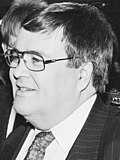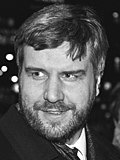| | First party | Second party | Third party |
|---|
| |  |  |  | | Leader | Esko Aho | Pertti Paasio | Ilkka Suominen |
|---|
| Party | Centre | SDP | National Coalition |
|---|
| Last election | 17.62%, 40 seats | 24.14%, 56 seats | 23.13%, 53 seats |
|---|
| Seats won | 55 | 48 | 40 |
|---|
| Seat change |  15 15 |  8 8 |  13 13 |
|---|
| Popular vote | 676,717 | 603,080 | 526,487 |
|---|
| Percentage | 24.83% | 22.12% | 19.31% |
|---|
| Swing |  7.21pp 7.21pp |  2.02pp 2.02pp |  3.82pp 3.82pp |
|---|
| | | Fourth party | Fifth party | Sixth party |
|---|
| |  |  |  | | Leader | Claes Andersson | Ole Norrback | Heidi Hautala |
|---|
| Party | Left Alliance | RKP | Green |
|---|
| Last election | 13.63%, 20 seats | 5.30%, 12 seats | 4.03%, 4 seats |
|---|
| Seats won | 19 | 11 | 10 |
|---|
| Seat change |  1 1 |  1 1 |  6 6 |
|---|
| Popular vote | 274,639 | 149,476 | 185,894 |
|---|
| Percentage | 10.08% | 5.48% | 6.82% |
|---|
| Swing |  3.55pp 3.55pp |  0.18pp 0.18pp |  2.79pp 2.79pp |
|---|
| | | Seventh party | Eighth party | Ninth party |
|---|
| |  |  | | | Leader | Toimi Kankaanniemi | Heikki Riihijärvi | Kaarina Koivistoinen |
|---|
| Party | Christian League | Rural Party | Liberal People's |
|---|
| Last election | 2.58%, 5 seats | 6.32%, 9 seats | 0.97%, 0 seats |
|---|
| Seats won | 8 | 7 | 1 |
|---|
| Seat change |  3 3 |  2 2 |  1 1 |
|---|
| Popular vote | 83,151 | 132,133 | 21,210 |
|---|
| Percentage | 3.05% | 4.85% | 0.78% |
|---|
| Swing |  0.47pp 0.47pp |  1.47pp 1.47pp |  0.19pp 0.19pp |
|---|
|










